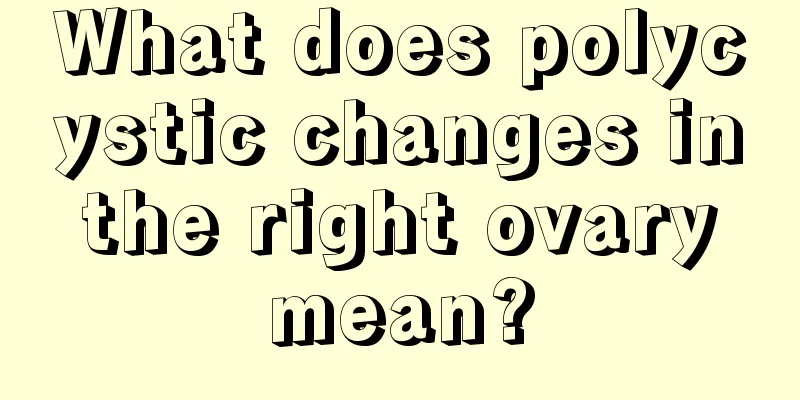What does polycystic changes in the right ovary mean?

|
When women have their bodies checked by B-ultrasound or color ultrasound, they will find some problems in their bodies. Some women's examination results will show polycystic changes in the right ovary. This symptom will cause female patients to have menstrual disorders and amenorrhea. In severe cases, it can also lead to excessive male hormones in the body, causing the ovaries to enlarge. So what does polycystic changes in the right ovary mean? First, what does polycystic changes in the right ovary mean? The symptoms of polycystic ovary changes mainly include menstrual disorders or even amenorrhea. Many patients with the disease will also have excessively high androgen levels and increased prolactin levels. The patient's ovaries will be enlarged, and multiple small follicles will appear. Even if ovulation is induced, ovulation disorders or luteinized cysts and thick ovarian walls may occur. It has a certain relationship with pancreatic islet antagonism. Immune substances may appear around the patient's ovaries, affecting the maturation or discharge of follicles. Second, some PCOS patients are insensitive to insulin, so their bodies produce more insulin. Approximately 30%-70% of patients have elevated insulin levels, which in turn stimulates the ovaries to synthesize more androgens, further inhibiting ovulation. What does polycystic changes in the right ovary mean? The pathological mechanism is mainly due to endocrine disorders that cause the ovaries to not ovulate for a long time. Due to the absence of ovulation, the level of luteinizing hormone increases, while the level of follicle-stimulating hormone (whose main function is to promote the growth and development of follicles) is relatively low. Due to the influence of high luteinizing hormone, androgen is 50%-150% higher than normal, androgen will further inhibit ovulation; anovulation also leads to a lack of cyclical progesterone secretion. This hormone secretion disorder further causes increased luteinizing hormone secretion, which in turn causes menstrual changes and obstructed follicle development, forming an interconnected "vicious circle." Polycystic ovary syndrome is a disease that occurs frequently in women of childbearing age. This disease is very harmful to women's health and can cause female infertility in severe cases. Therefore, female friends who suffer from polycystic ovary syndrome should pay attention to it. |
<<: What will happen if you move around frequently during confinement?
Recommend
Can I soak my feet after IVF?
In vitro fertilization is currently a relatively ...
What are the medicinal diet therapies for women's sexual frigidity?
Many married women suffer from low sexual desire,...
What are the ways to raise the placenta? What should I pay attention to when the placenta is low?
We all know that after a pregnant mother becomes ...
What are the reasons for pregnant women to urinate frequently at night?
Many pregnant women experience frequent urination...
The sleep crisis behind overweight teenagers
In my country, 19 out of every 100 teenagers aged...
What does it mean when the routine epithelial cell count for leucorrhea is three plus?
Leucorrhea is a white fluid that every sexually m...
Cystoovarian menstrual bleeding
For girls, protecting their health is very import...
How long does it take to start burning fat after breastfeeding?
Many women are very worried about obesity after p...
What to do if the amniotic fluid is not transparent
Poor amniotic fluid sound transmission refers to ...
What to do if you have a miscarriage at home
During pregnancy, the last thing people want to s...
Does the flower language of dianthus mean rejection? When should dianthus seeds be sown?
Dianthus is also called Luoyang Flower. Because i...
Can I sleep on an ice silk mat during confinement?
Confinement is another name for the physical reco...
How many days after caesarean section can I drink brown sugar water
Everyone knows that brown sugar ginger water is a...
Prominent pubic bone
The bone protrusion in the perineum is a normal s...
What is the cause of vaginal pain at 36 weeks of pregnancy?
Pregnant women cannot be careless about physiolog...









